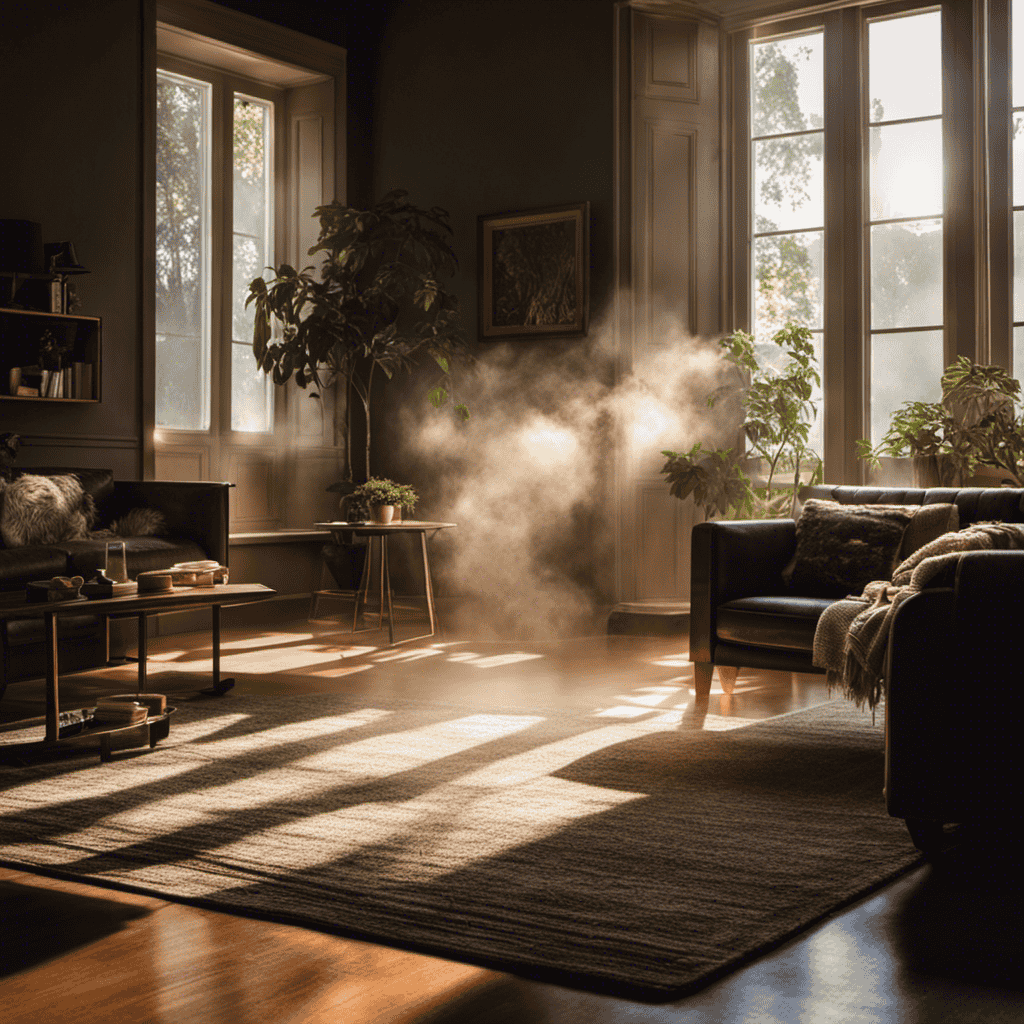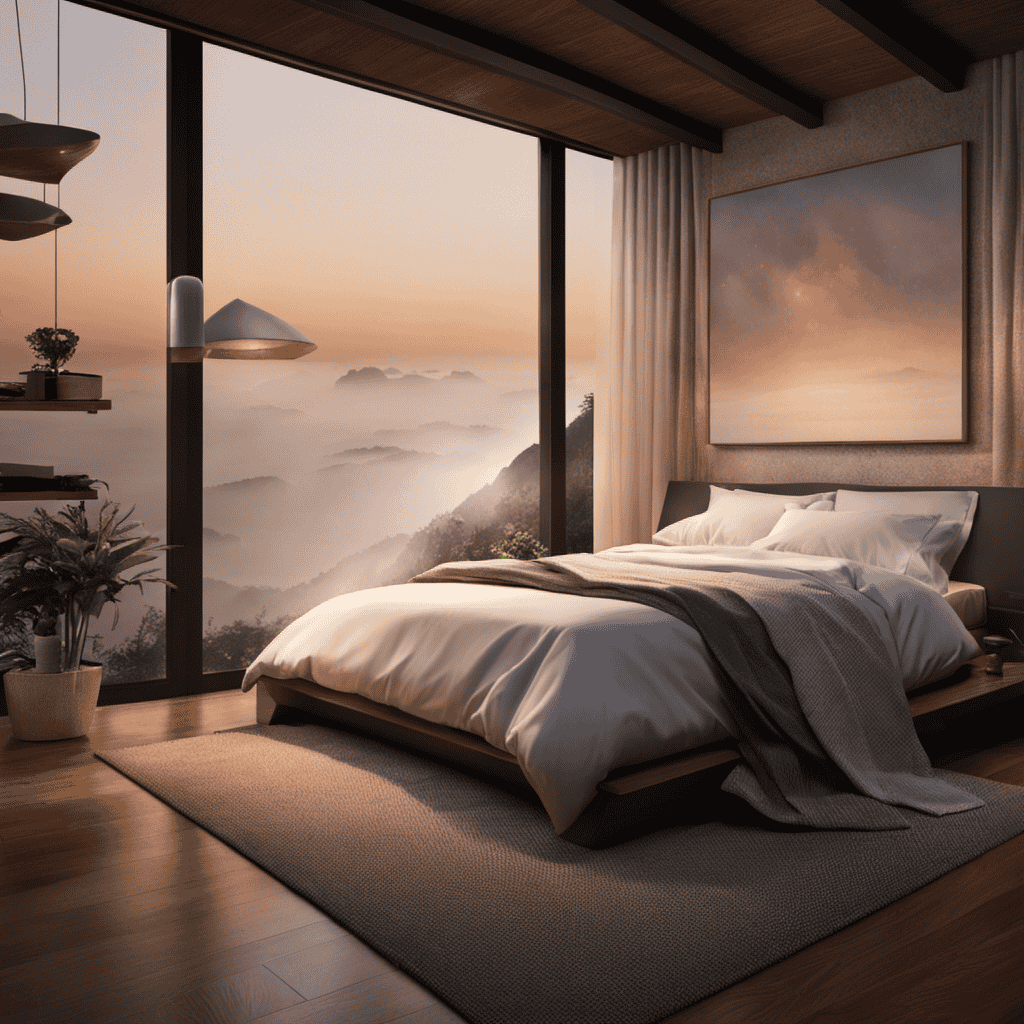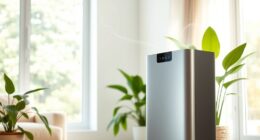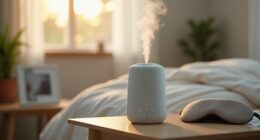I have always been worried about the air quality I breathe, particularly indoors. Were you aware that indoor air can be up to 5 times more polluted than outdoor air?
That’s why I decided to educate myself on how to tell if I need an air purifier. In this article, I’ll walk you through the signs of poor air quality, potential pollutants, ventilation systems, and more.
So, let’s dive in and learn how to breathe cleaner, healthier air at home.
Key Takeaways
- Assess indoor air quality through tests or monitoring devices to identify pollutants and their levels.
- Recognize signs and symptoms of poor air quality, such as coughing, wheezing, and shortness of breath.
- Understand the impact of poor air quality on respiratory health and the potential development of respiratory diseases.
- Consider allergies, sensitivities, and seasonal air quality changes when determining the need for an air purifier.
Assessing Indoor Air Quality
If you’re unsure about the quality of the air in your home, it’s important to assess it before deciding if you need an air purifier. Assessing indoor air quality involves evaluating the presence of air pollutants and determining if they are affecting your health and well-being.
There are several methods to assess air quality, such as conducting air quality tests or monitoring devices. These tools can measure levels of pollutants like dust, pollen, pet dander, mold spores, and volatile organic compounds (VOCs). By assessing the air pollutants in your home, you can identify if there are any issues that need to be addressed to improve indoor air quality.
Understanding the quality of the air in your home is crucial in determining whether an air purifier is necessary. Now, let’s explore the common signs of poor air quality and how they can help you make an informed decision.
Common Signs of Poor Air Quality
When it comes to discussing the physical symptoms of pollution and its impact on respiratory health, there are several key points to consider.
First, exposure to pollutants can lead to a range of physical symptoms such as coughing, wheezing, and shortness of breath.
Second, these symptoms can be particularly concerning for individuals with pre-existing respiratory conditions such as asthma or chronic obstructive pulmonary disease (COPD).
Lastly, the long-term effects of pollution on respiratory health can include the development or worsening of respiratory diseases, making it crucial to address and mitigate the sources of pollution.
Physical Symptoms of Pollution
You may experience physical symptoms such as coughing or sneezing if pollution levels are high. Evaluating these symptoms is crucial as they can indicate the presence of poor air quality and potential health effects.
Here are three common physical symptoms to watch out for:
-
Coughing: Persistent coughing can be a sign of irritation in the respiratory system caused by pollutants in the air. It is important to evaluate the frequency and severity of your cough to determine if it is related to pollution.
-
Sneezing: Excessive sneezing can occur when the air contains allergens or irritants. If you find yourself sneezing frequently or suddenly developing allergies, it could be a result of high pollution levels.
-
Shortness of breath: Difficulty breathing or a feeling of breathlessness can be a significant health effect of pollution. If you experience this symptom, it is essential to seek medical advice to determine the cause and address any potential risks to your health.
Impact on Respiratory Health
Take note of the impact pollution can have on your respiratory health.
Assessing air pollution levels and managing respiratory conditions are crucial for maintaining good respiratory health. High levels of pollutants in the air can lead to various respiratory problems, including worsened asthma symptoms, increased risk of respiratory infections, and the development of chronic respiratory diseases.
These pollutants can irritate the airways, causing inflammation and constriction, making it difficult to breathe.
It is important to regularly monitor air quality in your environment and take necessary precautions to protect your respiratory health, such as using air purifiers, wearing masks in polluted areas, and avoiding exposure to known pollutants.
Managing respiratory conditions and minimizing exposure to air pollution can significantly improve your overall respiratory health.
Understanding Allergies and Respiratory Issues
Understanding allergies and respiratory issues can help determine if an air purifier is needed. Here are three key points to consider:
-
Understanding triggers: Allergens such as pollen, dust mites, pet dander, and mold spores can worsen respiratory symptoms. Identifying the specific triggers that affect you can help determine if an air purifier is necessary.
-
Managing symptoms: If you frequently experience sneezing, coughing, wheezing, or nasal congestion, an air purifier may be beneficial. It can help remove allergens and irritants from the air, reducing your exposure and potentially alleviating symptoms.
-
Improving air quality: Even if you don’t have specific allergies, an air purifier can still be beneficial for improving overall air quality. It can help remove pollutants like smoke, VOCs, and airborne bacteria, creating a healthier indoor environment.
Understanding allergies and respiratory issues is crucial in determining whether an air purifier is necessary. Now let’s delve into identifying potential indoor air pollutants.
Identifying Potential Indoor Air Pollutants
Identifying potential indoor air pollutants is essential for maintaining a healthy indoor environment. By assessing pollutant levels and identifying common air toxins, we can take the necessary steps to ensure clean and safe indoor air. To help you understand the different types of pollutants that may be present in your home, here is a table outlining some common indoor air pollutants and their sources:
| Indoor Air Pollutant | Sources |
|---|---|
| Volatile Organic Compounds (VOCs) | Paints, cleaning products, furniture, carpets |
| Particulate Matter (PM) | Tobacco smoke, cooking emissions, dust, pollen |
| Carbon Monoxide (CO) | Gas stoves, furnaces, fireplaces |
| Formaldehyde | Building materials, insulation, furniture |
| Radon | Soil, groundwater, building materials |
Evaluating Your Home’s Ventilation System
Now that we have identified the potential indoor air pollutants in our previous subtopic, let’s move on to evaluating our home’s ventilation system.
It is crucial to assess the effectiveness of our ventilation system because it plays a significant role in maintaining good indoor air quality. Here are three key points to consider when evaluating ventilation effectiveness:
-
Airflow: Check if air is flowing freely throughout your home. Inspect vents and air registers to ensure there are no blockages or obstructions.
-
Air exchange rate: Measure the rate at which fresh outdoor air is being brought into your home and stale indoor air is being expelled. This can be done by consulting a professional or using specialized equipment.
-
Moisture control: Evaluate how well your ventilation system manages moisture levels. Excessive moisture can lead to mold and mildew growth, which can impact air quality.
Considering Lifestyle Factors
When it comes to indoor air quality, understanding the sources of pollutants and their impact on allergies and sensitivities is crucial.
Indoor pollutant sources can include things like pet dander, dust mites, mold, and even household cleaning products.
These pollutants can trigger allergic reactions in individuals who are sensitive, leading to symptoms such as sneezing, coughing, and itchy eyes.
Indoor Pollutant Sources
If you’re wondering whether you need an air purifier, it’s important to know that indoor pollutant sources can greatly affect your air quality. Assessing pollutant levels and understanding the importance of air circulation are key factors to consider.
Here are three reasons why indoor pollutant sources can impact your air quality:
-
Volatile Organic Compounds (VOCs): Commonly found in household cleaning products, paints, and building materials, VOCs can release harmful chemicals into the air, leading to respiratory issues and allergies.
-
Dust and pet dander: These allergens can accumulate over time and cause discomfort, especially for individuals with respiratory conditions or allergies.
-
Mold and mildew: Moisture-prone areas like bathrooms or basements can become breeding grounds for mold and mildew, which can release spores that worsen respiratory symptoms.
To ensure clean and healthy indoor air, proper ventilation and the use of air purifiers can help remove these pollutants, improving the overall air quality in your home.
Allergies and Sensitivities
To alleviate your allergies and sensitivities, consider implementing strategies such as regular cleaning, minimizing exposure to triggers, and using hypoallergenic products. Allergies can be triggered by a variety of environmental factors, including pollen, dust mites, pet dander, and mold. Identifying and avoiding these allergy triggers is crucial in managing your symptoms. Regular cleaning of your living space can help remove allergens and reduce their presence. Minimizing exposure to triggers such as keeping windows closed during peak pollen seasons, using dust mite-proof bedding, and keeping pets out of bedrooms can also make a significant difference. Additionally, using hypoallergenic products, such as fragrance-free detergents and cleaning supplies, can help minimize the risk of irritation. By implementing these strategies, you can create a more allergy-friendly environment and reduce the impact of environmental triggers on your health.
| Allergy Triggers | Environmental Triggers |
|---|---|
| Pollen | Dust Mites |
| Pet Dander | Mold |
Analyzing Seasonal Air Quality Changes
You can easily determine if you need an air purifier by analyzing the changes in seasonal air quality. Here are three key factors to consider when analyzing air pollution and its impact on seasonal allergies:
-
Pollen levels: During certain seasons, pollen counts can skyrocket, triggering allergies in many individuals. By monitoring the pollen levels in your area, you can assess if an air purifier is necessary to remove these allergens from your indoor environment.
-
Pollution index: Air pollution, such as smog or particulate matter, can worsen seasonal allergies and cause respiratory issues. By tracking the pollution index in your region, you can identify if the air quality is poor and if an air purifier is needed to filter out these harmful pollutants.
-
Allergy symptoms: If you notice an increase in allergy symptoms during specific seasons, it may indicate that your indoor air quality is not optimal. In this case, an air purifier can help remove allergens, providing relief from seasonal allergies.
Recognizing the Impact of Pets on Air Quality
Consider how having pets can affect the quality of the air in your home. Pets, especially those with fur or feathers, can release dander, hair, and feathers into the air. These particles can trigger allergies and respiratory issues in sensitive individuals.
Additionally, pet odors can contribute to poor indoor air quality. Regular grooming and cleaning of pet bedding and living areas can help minimize these effects.
It’s also important to note that smoking indoors can have a significant impact on air quality. Secondhand smoke contains harmful chemicals that can linger in the air and lead to respiratory problems.
Furthermore, household cleaning products can release volatile organic compounds (VOCs) that can negatively affect air quality. Choosing natural, non-toxic cleaning products can help reduce these effects and promote healthier indoor air quality.
Consulting With an Air Quality Professional
After realizing the impact of pets on air quality, it may be time to consult with an air quality professional. Seeking their expertise can provide valuable insights and guidance on improving your indoor air quality. Here are some benefits of consulting with a professional:
-
Accurate assessment: An air quality professional can conduct a thorough assessment of your home, identifying potential sources of pollution and measuring air quality levels.
-
Tailored recommendations: Based on the assessment findings, the professional can provide personalized recommendations to address specific issues and improve air quality.
-
Expertise and experience: Air quality professionals have extensive knowledge and experience in the field, allowing them to offer reliable advice and solutions.
Frequently Asked Questions
How Do Air Purifiers Work to Improve Indoor Air Quality?
Air purifiers work by filtering out airborne pollutants, such as dust, pollen, and pet dander. They improve indoor air quality by trapping these particles and preventing them from circulating, reducing the risk of respiratory issues and allergies.
Are There Any Potential Side Effects or Risks Associated With Using an Air Purifier?
I never thought using an air purifier could have potential side effects or risks. It’s important to consider the effectiveness, alternatives, maintenance, and filter replacement. Technology has come a long way in removing indoor air pollutants.
Can an Air Purifier Remove All Types of Indoor Air Pollutants?
An air purifier can effectively remove common indoor air pollutants, such as dust, pollen, pet dander, and mold spores. However, it may not eliminate all types of pollutants, such as volatile organic compounds or gases.
How Often Should I Replace the Filters in My Air Purifier?
I replace the filters in my air purifier every 3 months. Signs of dirty filters include reduced airflow and a buildup of dust or debris. Regular filter replacement ensures optimal performance and clean air.
Are There Any Alternative Methods or Strategies to Improve Indoor Air Quality Besides Using an Air Purifier?
Indoor air quality can be improved through alternative methods like using indoor plants and natural ventilation. These strategies help to filter and circulate fresh air, reducing the need for an air purifier.
What Are the Signs that You Need an Air Purifier?
If you notice persistent bad odors, increased dust accumulation, or allergy symptoms indoors, it may be signs that you need an air purifier. The air purifier benefits and uses include removing airborne pollutants, reducing allergens, and improving overall air quality in your home or office.
Conclusion
In conclusion, after carefully assessing the indoor air quality and understanding the signs of poor air quality, it is crucial to consider the need for an air purifier. Identifying potential pollutants in your home is also important in this process.
Just like a shield protects a knight in battle, an air purifier acts as a defender for your respiratory health, ensuring clean and fresh air to breathe.
Don’t hesitate to consult with an air quality professional to make an informed decision and safeguard your well-being.










